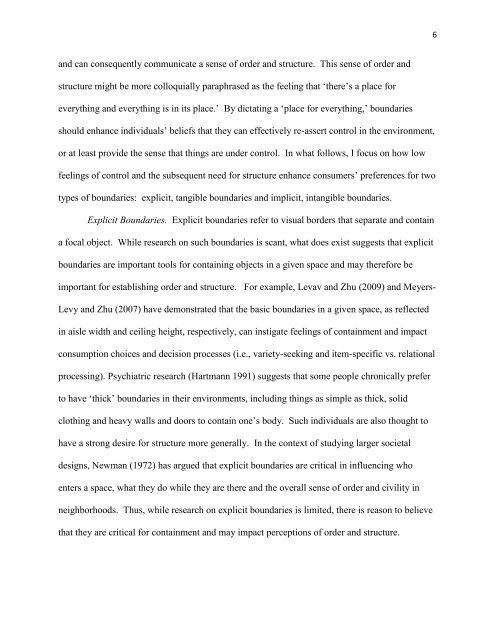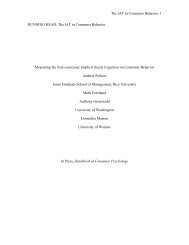The Beauty of Boundaries: When and Why We Seek Structure in ...
The Beauty of Boundaries: When and Why We Seek Structure in ...
The Beauty of Boundaries: When and Why We Seek Structure in ...
- No tags were found...
You also want an ePaper? Increase the reach of your titles
YUMPU automatically turns print PDFs into web optimized ePapers that Google loves.
6<strong>and</strong> can consequently communicate a sense <strong>of</strong> order <strong>and</strong> structure. This sense <strong>of</strong> order <strong>and</strong>structure might be more colloquially paraphrased as the feel<strong>in</strong>g that ‗there‘s a place foreveryth<strong>in</strong>g <strong>and</strong> everyth<strong>in</strong>g is <strong>in</strong> its place.‘ By dictat<strong>in</strong>g a ‗place for everyth<strong>in</strong>g,‘ boundariesshould enhance <strong>in</strong>dividuals‘ beliefs that they can effectively re-assert control <strong>in</strong> the environment,or at least provide the sense that th<strong>in</strong>gs are under control. In what follows, I focus on how lowfeel<strong>in</strong>gs <strong>of</strong> control <strong>and</strong> the subsequent need for structure enhance consumers‘ preferences for twotypes <strong>of</strong> boundaries: explicit, tangible boundaries <strong>and</strong> implicit, <strong>in</strong>tangible boundaries.Explicit <strong>Boundaries</strong>. Explicit boundaries refer to visual borders that separate <strong>and</strong> conta<strong>in</strong>a focal object. While research on such boundaries is scant, what does exist suggests that explicitboundaries are important tools for conta<strong>in</strong><strong>in</strong>g objects <strong>in</strong> a given space <strong>and</strong> may therefore beimportant for establish<strong>in</strong>g order <strong>and</strong> structure. For example, Levav <strong>and</strong> Zhu (2009) <strong>and</strong> Meyers-Levy <strong>and</strong> Zhu (2007) have demonstrated that the basic boundaries <strong>in</strong> a given space, as reflected<strong>in</strong> aisle width <strong>and</strong> ceil<strong>in</strong>g height, respectively, can <strong>in</strong>stigate feel<strong>in</strong>gs <strong>of</strong> conta<strong>in</strong>ment <strong>and</strong> impactconsumption choices <strong>and</strong> decision processes (i.e., variety-seek<strong>in</strong>g <strong>and</strong> item-specific vs. relationalprocess<strong>in</strong>g). Psychiatric research (Hartmann 1991) suggests that some people chronically preferto have ‗thick‘ boundaries <strong>in</strong> their environments, <strong>in</strong>clud<strong>in</strong>g th<strong>in</strong>gs as simple as thick, solidcloth<strong>in</strong>g <strong>and</strong> heavy walls <strong>and</strong> doors to conta<strong>in</strong> one‘s body. Such <strong>in</strong>dividuals are also thought tohave a strong desire for structure more generally. In the context <strong>of</strong> study<strong>in</strong>g larger societaldesigns, Newman (1972) has argued that explicit boundaries are critical <strong>in</strong> <strong>in</strong>fluenc<strong>in</strong>g whoenters a space, what they do while they are there <strong>and</strong> the overall sense <strong>of</strong> order <strong>and</strong> civility <strong>in</strong>neighborhoods. Thus, while research on explicit boundaries is limited, there is reason to believethat they are critical for conta<strong>in</strong>ment <strong>and</strong> may impact perceptions <strong>of</strong> order <strong>and</strong> structure.




